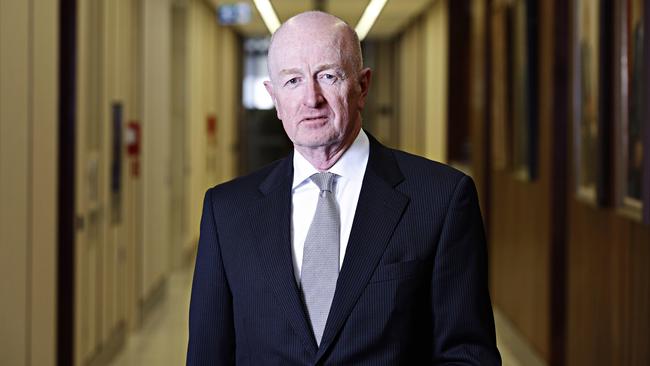Glenn Stevens: the ruthless banker who saved us from recession
Australia’s record of 25 years without a recession continues thanks to a ruthless central banker who held his nerve.

It was about four years ago that Stevens was a shag on a rock, monetary policy-wise. The Fed had interest rates at 0-0.25 per cent and was QE-ing like mad and the new president of the European Central Bank, Mario Draghi, had dramatically reversed his predecessor’s brief and ill-advised tightening, and was cutting for all he was worth.
In fact central bankers everywhere either had interest rates at zero or were heading there, and were printing money in the mistaken belief that interest rates couldn’t go below zero.
But in October 2011, Glenn Stevens had had the Australian cash rate at 4.75 per cent for 12 long months, having raised it from 3 per cent three years earlier, and must have been feeling very lonely at the top. He was almost alone among central bankers in doing that; Israel and Brazil were the only others.
It was a remarkable thing to do, and echoed his own predecessor, Ian Macfarlane’s courage in 2002, when he raised interest rates a full two years before Alan Greenspan’s Fed, thereby heading off the sort of housing bubble that eventually brought the US economy undone.
The huge interest rate differential that Stevens set up between Australia and the US helped take the Australian dollar above parity with the US dollar on November 3, 2010, and dragged the GDP growth rate down from 4 per cent to 2 per cent.
Two years of an above-parity exchange rate later, the car industry gave up the ghost, marking what seemed to be the demise of Australian manufacturing.
But in fact those seven rate hikes between October 2009 and November 2010 represent one of the most ruthless, intelligent and courageous episodes of macro-economic policy ever seen.
Stevens would have known what he was doing to manufacturing, and therefore to peoples’ lives. The unemployment rate went from 4.9 per cent in mid-2011 to 6.2 per cent at the end of 2014.
But there’s very little doubt that if Glenn Stevens and the RBA board had not brutally leant against the last burst of the mining boom in 2009-10, as China’s post-GFC fiscal stimulus fed into commodity prices, and then held their nerve, Australia would now be in recession. In a way Stevens was countering the wild fiscal spending of two governments: China and Australia.
After the GFC, China unleashed the greatest fiscal stimulus the world had ever seen, and by 2010 it was still going flat out. In per capita terms, Australia’s 2008-09 fiscal stimulus was probably even greater, and in 2010 the new Gillard Labor government also had not turned off the tap — spending kept going much longer than it was needed.
Brazil’s central bank also leant against the mining boom in 2010, raising the policy rate from 8.75 to 12.5 per cent, but lost its nerve and quickly cut it back to 7.25 per cent. It then had to go into reverse again and hike back to 14.25 per cent as inflation spiked, and since then Brazil has been suffering a terrible recession. In essence, by tightening monetary policy between 2009 and 2010, Glenn Stevens delayed the housing boom until the mining boom had finished. Melbourne house prices fell for two years and Sydney prices flattened out; building approvals fell.
There was more to it than that, but by ensuring that housing and mining didn’t boom at the same time, and that monetary policy made some economic room for that last leg of the mining boom, Glenn Stevens also made sure that it didn’t end up in recession.
Instead growth is back up to where it was four years ago, and above trend, and the unemployment rate is back down to 5.7 per cent. Australia’s remarkable record of 25 years without a recession continues, thanks to a quietly ruthless central banker who did not lose his nerve.
That was Glenn Stevens’ greatest achievement, in my view, but he did much more: most significantly, he made the cloistered RBA much more transparent, publishing the minutes of board meetings two weeks after each meeting.
What he couldn’t bring himself to do was have press conferences. Maybe that can be Phil Lowe’s contribution.






It’s fitting that Glenn Stevens’ final week as governor of the Reserve Bank was marked by a four-year high for economic growth.